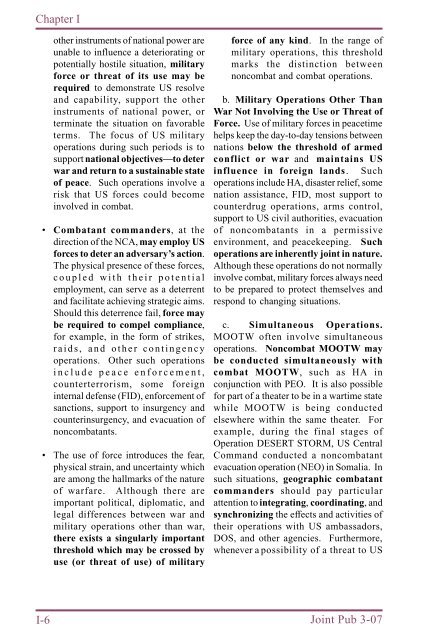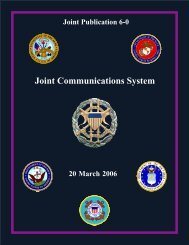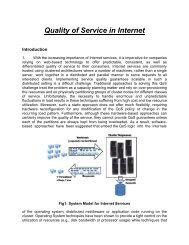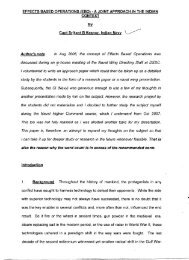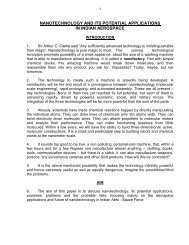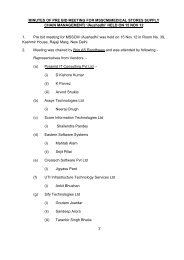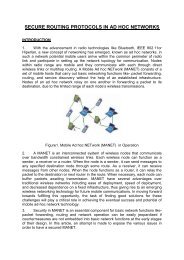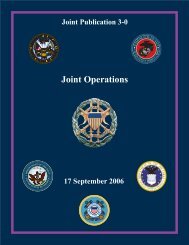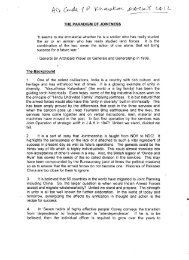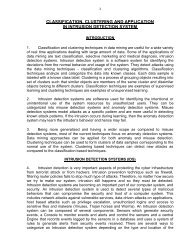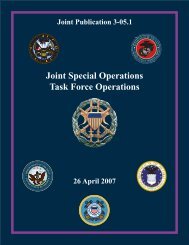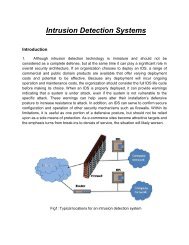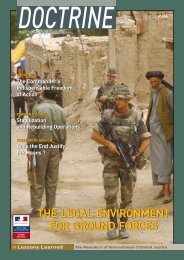JP 3-07 Joint Doctrine For Military Operations Other Than War
JP 3-07 Joint Doctrine For Military Operations Other Than War
JP 3-07 Joint Doctrine For Military Operations Other Than War
- No tags were found...
You also want an ePaper? Increase the reach of your titles
YUMPU automatically turns print PDFs into web optimized ePapers that Google loves.
Chapter Iother instruments of national power areunable to influence a deteriorating orpotentially hostile situation, militaryforce or threat of its use may berequired to demonstrate US resolveand capability, support the otherinstruments of national power, orterminate the situation on favorableterms. The focus of US militaryoperations during such periods is tosupport national objectives—to deterwar and return to a sustainable stateof peace. Such operations involve arisk that US forces could becomeinvolved in combat.• Combatant commanders, at thedirection of the NCA, may employ USforces to deter an adversary’s action.The physical presence of these forces,coupled with their potentialemployment, can serve as a deterrentand facilitate achieving strategic aims.Should this deterrence fail, force maybe required to compel compliance,for example, in the form of strikes,raids, and other contingencyoperations. <strong>Other</strong> such operationsinclude peace enforcement,counterterrorism, some foreigninternal defense (FID), enforcement ofsanctions, support to insurgency andcounterinsurgency, and evacuation ofnoncombatants.• The use of force introduces the fear,physical strain, and uncertainty whichare among the hallmarks of the natureof warfare. Although there areimportant political, diplomatic, andlegal differences between war andmilitary operations other than war,there exists a singularly importantthreshold which may be crossed byuse (or threat of use) of militaryforce of any kind. In the range ofmilitary operations, this thresholdmarks the distinction betweennoncombat and combat operations.b. <strong>Military</strong> <strong>Operations</strong> <strong>Other</strong> <strong>Than</strong><strong>War</strong> Not Involving the Use or Threat of<strong>For</strong>ce. Use of military forces in peacetimehelps keep the day-to-day tensions betweennations below the threshold of armedconflict or war and maintains USinfluence in foreign lands. Suchoperations include HA, disaster relief, somenation assistance, FID, most support tocounterdrug operations, arms control,support to US civil authorities, evacuationof noncombatants in a permissiveenvironment, and peacekeeping. Suchoperations are inherently joint in nature.Although these operations do not normallyinvolve combat, military forces always needto be prepared to protect themselves andrespond to changing situations.c. Simultaneous <strong>Operations</strong>.MOOTW often involve simultaneousoperations. Noncombat MOOTW maybe conducted simultaneously withcombat MOOTW, such as HA inconjunction with PEO. It is also possiblefor part of a theater to be in a wartime statewhile MOOTW is being conductedelsewhere within the same theater. <strong>For</strong>example, during the final stages ofOperation DESERT STORM, US CentralCommand conducted a noncombatantevacuation operation (NEO) in Somalia. Insuch situations, geographic combatantcommanders should pay particularattention to integrating, coordinating, andsynchronizing the effects and activities oftheir operations with US ambassadors,DOS, and other agencies. Furthermore,whenever a possibility of a threat to USI-6<strong>Joint</strong> Pub 3-<strong>07</strong>


